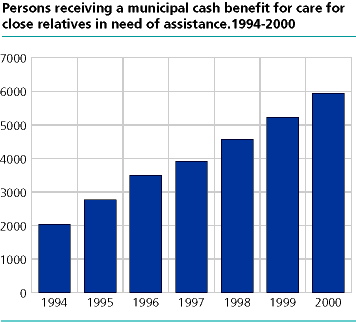Content
Published:
This is an archived release.
More users of home-based services
Nearly 159 700 persons received practical assistance or home-nursing in their homes at the end of 2000. This is the highest figure reported since the reorganisation of the statistics in the early 1990's.
In contrast to residents in institutions, where a minority is less than 67 years of age, nearly a quarter of the users of home services were in this age category. Close to 40 per cent of the users receive practical assistance as the only means of help, i.e. home help. Nearly 6 000 users received care for more than 35.5 hours per week from home helpers or home nursing. This is an increase of 400 persons compared to 1999.
19 800 persons received special support by the end of 2000. 13 600 of these recipients were less than 50 years of age. 7 900 persons received respite care. Nearly two thirds of the recipients where aged 18 or below.
More than 5 900 persons received a cash benefit from their municipality in exchange for caring for children, parents or other close relatives in need of assistance. The number of caregivers receiving such cash benefits has more than doubled since 1994.
More beds in nursing homes
Of the 42 900 beds in institutions for the elderly and disabled, 36 100 are beds in nursing homes, an increase of more than 400 beds since 1999. As in previous years, the number of nursing home beds has risen, while the number of beds in old peoples homes has declined, with 6 100 beds left at the end of 2000. There are now a total of 1047 institutions. This is ten institutions more than in 1999.
In 2000 the institutions had more than 37 700 rooms, of which 86 per cent were single rooms. Since the beginning of the 1990s, the percentage of single rooms has increased by 7.3 percentage points. By the end of the year 42 200 persons lived in institutions. Nearly 75 per cent of the residents were above 80 years, while close to 4 per cent were under the age of 67. Women account for more than 70 per cent of all residents in institutions. More than three out of four women were aged 80 years or over.
Close to 88 per cent of the residents in institutions have been admitted for a long-term stay, i.e. a stay, which was meant to last more than three months at the time of admittance. A half per cent of the long-term residents were aged 50 years or below.
More dwellings for elderly and disabled
As for the institutions, the number of dwellings for elderly and disabled users increased from 1999 to 2000. The number of these dwellings grew rapidly in the second half of the 1990s. More than 46 400 dwellings were registered in the statistics in 2000, of which three-fourths are owned by the municipalities. Of the dwellings were 13 100 care services-linked units built with a Norwegian State Housing Bank start-up subsidy. The number of these units has increased by nearly 7 700 since the first time they were registered in the statistics in 1997.
At the end of the year, about 45 500 persons lived in dwellings for the aged and disabled. Younger residents, i.e. those under 67 years of age, account for nearly 30 per cent of all residents of such dwellings, while those 80 years and older account for 43 per cent. Two out of three residents in dwellings were women. Men are in majority only among the residents aged 50 and below.
Steady increase in man-years
Man-years in the nursing and care services have increased by 3 300 from the end of 1999 to the end of 2000. In 2000 the total number of employees was 89 700 man-years, or around 0.44 man-years per user.
Tables:
- Table 1 Beds in institutions for the aged and disabled, by type of ward.1996-2000
- Table 2 Rooms in institutions for the aged and disabled, by type of room. Per cent. 1991-2000
- Table 3 Residents in institutions for the elderly and disabled, by age. 1992-2000
- Table 4 Residents in dwellings for the aged and disabled. Number of dwellings. 1994-2000
- Table 5 Users of home-based services, by age. 1992-2000
- Table 6 Man-years within the nursing and care services. 1992-2000
- Table 7 Beds in institutions for the elderly and disabled. 1991-2000
- Table 8 Users of home based services, by kind of service. The whole country. 1992-2000
Contact
-
Dag Ragnvald Abrahamsen
E-mail: dag.ragnvald.abrahamsen@ssb.no
tel.: (+47) 40 90 25 46
-
Øyvind Isachsen Berntsen
E-mail: oyvind.berntsen@ssb.no
tel.: (+47) 40 90 23 28
-
Bjarne Tautra Hoen
E-mail: bjarne.hoen@ssb.no
tel.: (+47) 40 90 25 99
-
Linda M. Allertsen
E-mail: linda.allertsen@ssb.no
tel.: (+47) 97 09 97 51

